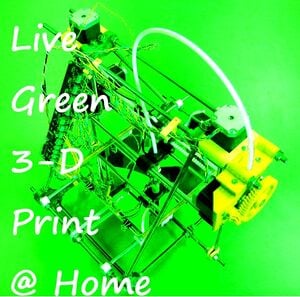
With the recent development of the RepRap, an open-source self-replicating rapid prototyper, low-cost 3-D printing is now a technically viable form of distributed manufacturing of polymer-based products. However, the aggregate environmental benefits of distributed manufacturing are not clear due to scale reductions and the potential for increases in embodied energy. To quantify the environmental impact of distributed manufacturing using 3-D printers, a life cycle analysis was performed on three plastic products. The embodied energy and emissions from conventional large-scale production in low-labor cost countries and shipping are compared to experimental measurements on a RepRap with and without solar photovoltaic (PV) power fabricating products with acrylonitrile butadiene styrene (ABS) and polylactic acid (PLA). The results indicate that the cumulative energy demand of manufacturing polymer products can be reduced by 41-64% (55-74% with PV) and concomitant emission reductions using distributed manufacturing with existing low-cost open-source 3-D printers when using <25% fill PLA. Less pronounced positive environmental results are observed with ABS, which demands higher temperatures for the print bed and extruder. Overall, the results indicate that distributed manufacturing using open-source 3-D printers has the potential to have a lower environmental impact than conventional manufacturing for a variety of products.
Discussion on how 3D printing is green on Living on Earth - PRI's Environmental News Magazine - Listen
See also[edit | edit source]
- Environmental impacts of distributed manufacturing from 3-D printing of polymer components and products - A preliminary study presented at the MRS
- Ethical Filament Foundation
- Compatibility of 3-D printed devices in cleanroom environments for semiconductor processing
Method[edit | edit source]
In the News[edit | edit source]
| 3D Print. Save the Planet. |
|---|
- 3D Printing: The Greener Choice -- Michigan Tech News Environmental Research Web, Communications of the ACM, Power source
- 3-D printing: Making your own saves energy, scientist says - Phys.org
- Home 3D Printing Can Be Greener Than Importing Plastic Goods - Motherboard
- 3D printers use less energy than traditional manufacturing - Gigaom
- Making household items on 3D printer said greener than factory versions - UPI
- 3D printing isn't just cheaper, it's also greener, scientist says - 3Ders
- 3D Printing Is Greener Than Conventional Production - Red Orbit
- 3D printing is a Cheap, Green Way of Making Things - Nature World News
- Turns Out 3D-Printing At Home is Both Cheaper And Greener Than Factory Products - Science World Report
- 3D printing lowers environmental impact, says study - Kurzweil
- 3D Printing is Greener - Engineering.com
- 3D Printing Can Make the World More Green - 3Dprinting.com
- 3d-skrivare spar miljön - NyTeknik New Technology Sweden)
- Printarea 3D, solutie de productie ecologica - Ecomagazin (Romania)
- 3D Sustainability- Ensia
- Good news for 3D print enthusiasts - The Stochastic Scientist
- 3D Printing a Greener Alternative to Traditional Manufacturing - 3D Printer World
- 3D Printing Beats Mass Production In Energy Efficiency - Tech the Future
- 3D Printing: Making Cheap Plastic Environmentally Sustainable - Pachamama Alliance
- Marble EcoDesign: Marble Waste to 3D Printing Gold - 3D Printing Industry
- How Green is 3D Printing? - ECOS Magazine
- 3D Printer Test - Conservation Magazine
- Printing: Low Volume Production by 3D Printing More Eco-Friendly Than Traditional Manufacturing - Formtek
- What price our fascination with cheaper 3D printing? - The Conversation
- 3D printers may be poised to take off in developing countries - Engineering for Change
- Stampare 3D in casa non solo è meno costoso, ma è anche più ecologico - Scienze Naturali.it (Italian)
- New Technology That Helps the Environment - Real Business
- 3D printers may be poised to take off in developing countries - Engineering for Change
- How Eco-Friendly is 3D Printing in 2015? - Trinkle
- El viaje de la impresión 3D: del edificio icono a la construcción in the social innovation Spanish publication Sacyr


